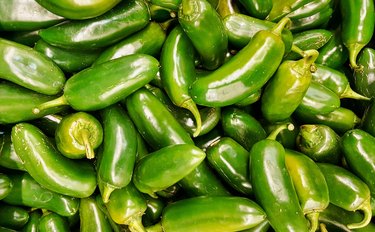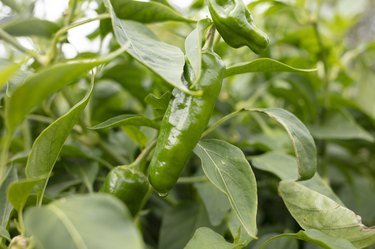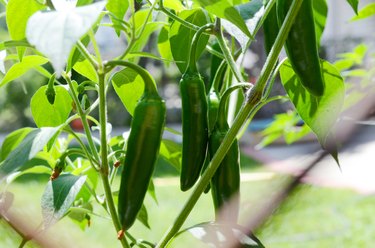
Native to Mexico, jalapeño peppers (Capsicum annuum 'Jalapeño') are one of the most popular types of hot peppers. Jalapeños are used in sauces and salsas and as a topping for nachos. There are a number of jalapeño pepper varieties to grow, and they are different in color, size and heat level. All jalapeño pepper plants need plenty of moisture, especially when setting and producing fruit.
Watering Jalapeño Plants
Video of the Day
As a general rule, you want to water jalapeño plants frequently enough to keep the soil from completely drying out, which will depend in part on weather conditions. During hot, dry spells, pepper plants will need more water. Water jalapeño plants to a depth of 6 inches to encourage root development. A layer of mulch can help conserve soil moisture. Well-drained soil is key for pepper plants, so consider growing your jalapeños in a raised bed if the soil you are working with does not drain well.
Video of the Day
It is important to provide jalapeño pepper plants with just the amount of water. You should never allow pepper plants to wilt because, according to the Colorado Integrated Food Safety Center of Excellence, they will have a hard time bouncing back after being exposed to drought-like conditions. Blossom-end rot – dark, sunken leathery patches that appear on the bottom of peppers and other vegetables when there is a calcium deficiency – can also occur as a result of too much or too little water, which makes it hard for the plants to absorb nutrients. Too much water can also lead to root rot and make the peppers susceptible to pathogens.
Growing Jalapeño Peppers
In places with cool winters where it takes a while for soil and air temperatures to rise in the spring, start jalapeño peppers seeds indoors eight weeks before you plan to transplant them into the garden. The Utah State University Extension says seedlings should develop strong roots and grow 6 to 9 leaves before you transplant them. Water seedlings regularly during this time.

Because jalapeño peppers grow best in warm weather, wait until nighttime temperatures are above 50 degrees to transplant them outside. Pepper plants produce the most fruit when daytime temperatures are between 85 and 95 degrees Fahrenheit and nighttime temperatures are between 65 and 70 degrees. Peppers grown in warm, sunny spots will taste better than those grown in the shade in lower temperatures.
Jalapeño Peppers Varieties
According to the Clemson University Extension, jalapeño peppers range from 2,500 to 8,000 Scoville Heat Units (SHU), which are used to convey how hot a pepper is. Jalapeño peppers also differ in the amount of time it takes them to reach maturity.
The 'Señorita' jalapeño is considered one of the hotter options, with 5,000 SHU on the Scoville scale, and it is ready for harvest approximately 80 days after planting. These jalapeños are green when they emerge and turn to purple and finally red. 'Fresno Chile' jalapeños are much milder than the 'Señorita' variety, with 300 to 400 SHU. They are smaller and are ready faster than 'Señorita' jalapeño.

'Sierra Fuego' jalapeños which, like 'Fresno Chile' jalapeños, are considered mild, take some 80 days to reach maturity. 'Mucho Nacho' jalapeños, one of the faster growing varieties, are ready for harvesting just 68 days after planting.